The best credit card readers for iPhones are:
The statement “iPhones are popular products” might be a bit of a truism, but there is at least one not-so-obvious implication with some value. Popular products tend to be well served in a market, with plenty of peripherals and software designed to work with said products. For example, mobile POS card readers.
Top iPhone card readers comparison
We’ve gone ahead and made a few core assumptions while putting this list together. For one, if you’re just looking for a mobile card reader, specifically iPhone-compatible ones, you’re likely wanting one or more of the following qualities:
- Hardware that’s untethered from a stationary location.
- Favorable transaction fees.
- Card readers that can accept a variety of payment types.
Based on those guidelines, we’ve highlighted some of the core features and capabilities of our picks and compared them side-by-side in the table below:
| Our rating (out of 5) | POS device cost | Lowest transaction fee | OS compatibility | Payment type limitations | |
|---|---|---|---|---|---|
| Square Reader | 4.58 | $59 | 2.6% + $0.10 per swipe | iOS/Android | No swipe |
| SumUp Plus | 4.36 | $54 (or free with subscription) | 2.6% + $0.10 per transaction | iOS/Android | None |
| Shopify Tap & Chip | 4.20 | $49 | 2.4% + $0.10 per transaction | iOS/Android | No swipe |
| Clover Go | 4.13 | $59 | 2.6% + $0.10 per transaction | iOS/Android | None |
| Stripe M2 | 4.05 | $199 | 2.9% + $0.30 per transaction | iOS/Android, React Native | None |
Square Reader: Best overall
Our rating: 4.58

Maybe you haven’t heard, but Square is kind of a big deal. They’re…kind of the progenitor of this whole class of products—their original aux plug card reader was the first of its kind. Square’s offerings have obviously expanded quite a bit since then, but their basic Square Reader (offered for free when you create an account to use their processing services) remains the entry point for many into the world of taking payments via mobile.
A level up from the free reader, Square offers a chip and tap reader that can pair with your iPhone to accept contactless and chip payments.
Beyond their card readers, Square offers full POS hardware setups, as well as the payment processing services that these point-of-sale solutions use, both for in-person transactions and ecommerce sales.
Why I chose Square Reader
Square was an easy pick, if for no other reason than the free card reader. If all you need is a peripheral to take card swipes, don’t want added costs, and don’t mind using Square as your processor, odds are it’s a perfect fit. Even if you want to take chip and contactless payments, Square’s chip and tap reader is an excellent choice.
While Square’s hardware requires using Square’s payment processing, these are still popular solutions for their long list of compatibility and integrations, as well as their reliable payment services.
Pricing
Hardware fees
- Magstripe reader: First one free.
- Chip and tap reader: $59.
Subscription fees
- Free: $0/month, and includes free Square Reader; pay only processing fees.
- Plus: Starting at $29/month, plus processing fees.
- Premium: Custom monthly subscription, plus processing fees.
Processing fees
- In-person: 2.6% + $0.10 per transaction.
- Online: 2.9% + $0.30 per transaction.
- Manual entry: 3.5% + $0.15 per transaction.
- Invoices: 3.3% + $0.30 per transaction.
Features
- Every account comes with a free card reader.
- Flat processing fee for all in-person transactions.
- Accept payments via nearly every available channel.
- A wide selection of business services available as add-ons.
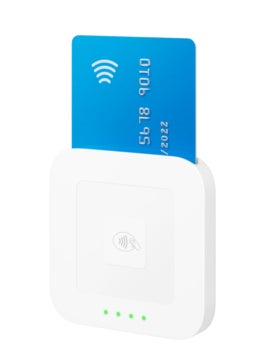
Pros and cons
| Pros | Cons |
|---|---|
| Least expensive card reader in the list (free peripheral, no subscription fee). | Free reader only takes magstripe swipes (no chip, dip, NFC, or mobile wallet). |
| Leading POS and payment processing provider for in-person transactions. | Add-on services can become expensive quickly. |
| Base subscription cost for paid plans is lower than most. | Hardware requires Square payment processing. |
| Reliable hardware, trusted brand. | Transaction rates much less favorable for online, keyed-in, or invoiced payments. |
| Favorable in-person transaction rates. |
SumUp Plus: Best hassle-free option
Our rating: 4.36

There is something to be said for flexibility, and getting the job done with the least amount of effort or resistance. That’s where SumUp’s entry-level card reader comes in.
The SumUp Plus card reader is an excellent choice for businesses that want a mobile reader that’s quick to set up and easy to use without paying a fortune or limiting accepted payment types.
Why I chose SumUp Plus
Like Square Reader, you can get the SumUp Plus for free with a subscription. But that’s not why it’s on our list. No, SumUp Plus is on our list because you can use it basically anywhere for anything.
It takes virtually every form of card payment, including Apple Pay, Google Pay, and Samsung Pay. And you can run as many as 500 transactions on a single charge. If you need to use it while it’s charging and don’t mind being rooted to the spot, you can spring for the charging dock and have it serve as a more traditional countertop POS station.
All in all, SumUp covers the majority of important POS functions at an affordable price without added hurdles to jump over.
Pricing
Hardware fees
- SumUp Plus: $54.
- SumUp Solo: $99.
- SumUp Solo Printer Bundle: $169.
Subscription fees
- Payment processing only: $0.
- POS with Connect Lite: $99/month.
- POS with Connect Plus: $199/month.
- POS with Connect Pro: $289/month.
Processing fees
- In-person: 2.6% + $0.10 per transaction.
- Online/manual entry: 3.5% + $0.15 per transaction.
- Invoicing: 2.9% + $0.15 per transaction.
Features
- PIN pad on every card reader.
- Accepts all major payment types and methods.
- Lengthy battery life for those who need it.
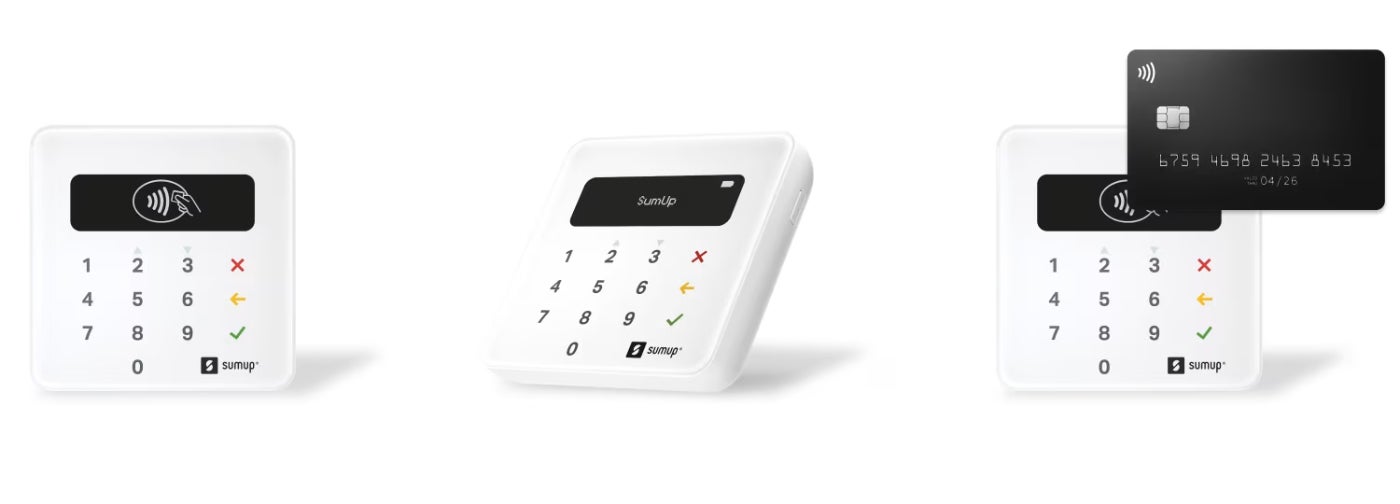
Pros and cons
| Pros | Cons |
|---|---|
| POS software available. | Higher transaction fees for online and manual entry transactions. |
| Accepts nearly every payment type. | No free tier. |
| Easy to set up, easy to operate. | Slightly higher than average subscription costs. |
Shopify Tap & Chip: Best for ecommerce
Our rating: 4.20

Another major player in the digital payment space, Shopify is known across the ecommerce industry for its merchant services and online payment processing. That doesn’t mean they don’t have ample offerings for physical locations and in-person transactions.
Their entry-level product, Shopify Tap & Chip, enables businesses to take card payments from just about anywhere and via nearly every payment format (minus swipe). At only $49, the reader is budget friendly, and with Shopify’s lowest cost subscription at just $5 per month, you can get started even if you’re working with next-to-no budget at the beginning.
Why I chose Shopify Tap & Chip
Different businesses are at different stages, with some having the flexibility to afford more expensive solutions, and others constrained by their limited resources. A lot of times, this is all defined by the age of the business, with professionals that are just starting to sell seeking to avoid incurring needless upfront costs.
Shopify’s Tap & Chip reader is a way to do just that. Sign up with a subscription for just $5 a month, and snag a reader for less than $50, and you’re ready to roll. Plus, as a market leader in ecommerce and payment processing, Shopify can even make the transition to online selling a breeze once you’re ready to make that move.
Pricing
- Starter: $5/month, with in-person rates starting at 5% + $0.00 per transaction.
- Retail: $79/month (or $89/month when paid monthly), with in-person rates starting at 2.6% + $0.10 per transaction.
Features
- Reliable card reader with lengthy battery life, that accepts most major payment types and methods.
- Lower-than-average hardware price and subscription fees, to get you started faster at an affordable cost.
- Get access to extensive ecommerce tools and solutions, and upgrade to leverage advanced features at any time.
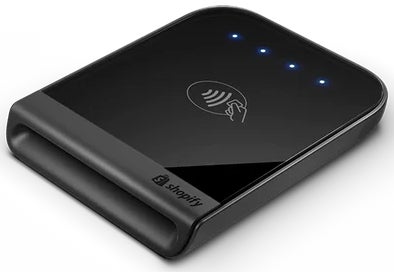
Pros and cons
| Pros | Cons |
|---|---|
| Get started for less than most, and try it first for free. | Transaction fees much higher for Starter plan subscribers. |
| Upgradable subscription to reduce transaction fees, add ecommerce functionality, operate multiple locations, and more. | No free tier, no free hardware. |
| Card reader accepts all card payments except magstripe, with a day-long battery life. | 3rd-party payment processing only available for online transactions (and comes with a hefty fee for most subscription tiers). |
| Reader does not accept magstripe payments. |
Clover Go: Best processor agnostic
Our rating: 4.13

Clover Go is our pick for the POS device with the best optional features and functionality.
Just to clarify, we’re not saying that Clover brings the widest set or most expansive list of features to the table. What Clover does do well is point-of-sale hardware.
Clover offers some of the most powerful pieces of POS hardware on the market, all of which are processor-agnostic. You can pay for hardware upfront or roll the monthly commitment in with your regular subscription until the device is paid off.
Rapid Deposit allows you to receive funds within minutes of a card transaction. Clover Capital offers cash-advance options. Manage employee shifts right from the Clover app, and use the payroll integration add-on if you need it. In short, Clover is tailored to in-person sales in ways that very few other vendors are.
Why I chose Clover Go
The base price of the Clover Go POS is much higher than others in this list, but the subscription costs are on the lower end, as are the in-person transaction fees. Beyond that, the Clover Go can handle basically any payment except a magstripe swipe, and the extensive optional features are impressive all on their own.
Pricing
- Device-only: $199 (one-time fee).
- Device plus Essentials plan: $199 (one time fee) + $14.95/month.
Features
- Can work with any processor on the FISERV network.
- Affordable subscription and transaction costs.
- Accepts tap, dip, mobile wallets, and more.
- Optional features for rapid deposit, payroll integration, sales reports, loyalty programs, and more.
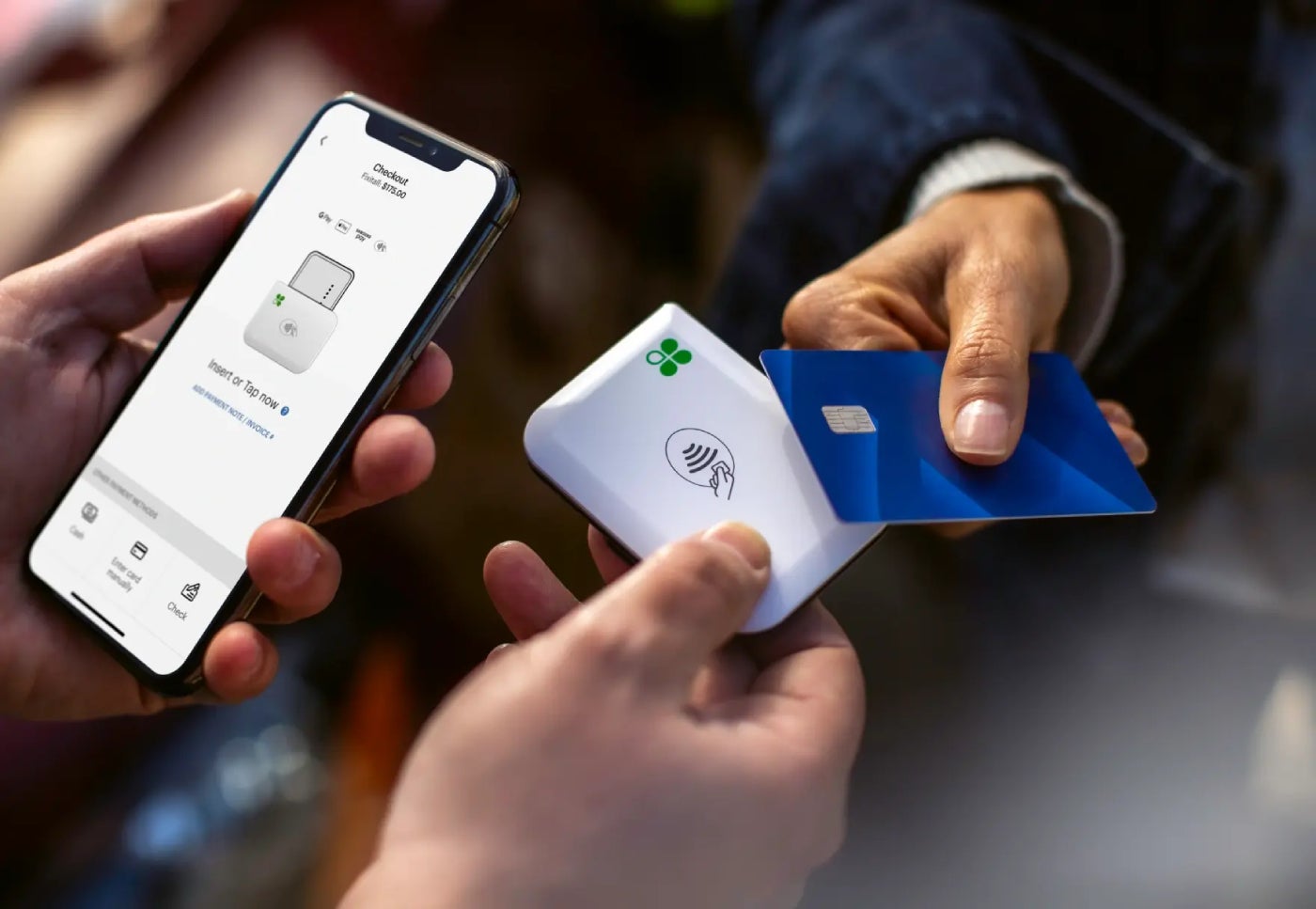
Pros and cons
| Pros | Cons |
|---|---|
| Premium POS functionality. | Individual products (Clover Go, other POS devices) cost more than most in this space. |
| Software features designed with in-person transactions in mind. | Less equipped to facilitate online/ecommerce transactions. |
| Completely payment processor agnostic (i.e., Bring Your Own Merchant Account). | |
| Inexpensive subscriptions and in-person transaction fees. | |
| One of the largest POS hardware catalogs in the market. |
Stripe M2: Best on-the-go option
Our rating: 4.05

We’ll close out our list with the Stripe M2. This unassuming little doodad does basically everything. It takes swipe, chip, tap, dip, and digital wallet payments. It charges in just 2 hours and boasts up to 28 hours of battery life for active use. It’s the only entry on this list that’s compatible with more than just iOS and Android operating systems.
Oh, and it has an offline mode, in case, you know, you need to make a sale but don’t have wifi.
It’s not necessarily the cheapest, the most chock-full of features, or the most flashy (though it’s far from a slouch in all of those areas). But at a reasonable price and reliable functionality, this little card reader can go anywhere your business does.
Why I chose Stripe M2
Offline mode isn’t required for everyone, but the businesses that need it often can’t live without it. On that feature alone, Stripe M2 stands out from the rest of this list in terms of reliability.
Beyond that, the Stripe M2 has absurdly long battery life and accepts every payment method under the sun. This truly is what “anywhere operations” looks like for in-person transactions.
Pricing
- Stripe M2 device cost: $59.
- 2.9% + $0.30 per successful transaction with domestic cards.
- No monthly fees, subscriptions, or surprise charges.
Features
- Reasonably affordable pricing for both device and transaction fees.
- Go anywhere with impressive battery life and offline mode.
- Accept cards in every way they might be used, and digital wallets beyond that.
- Flat transaction rate for all types — not the least expensive, but well below the less favorable rates of other vendors in this list.
- Complete developer documentation and open API access to build your own iOS payment app or other processing solution.
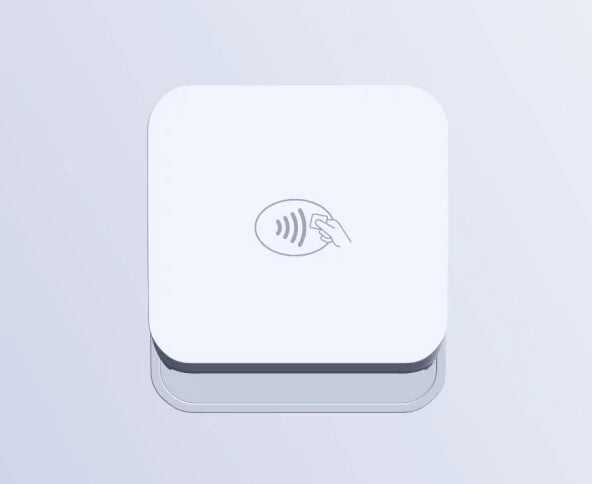
Pros and cons
| Pros | Cons |
|---|---|
| Flat rate transaction fees, at better rates than most. | Fees are still slightly higher than some competitors, if all you take are in-person transactions. |
| Take Stripe M2 anywhere, and even use it offline. | Payouts are customizable and predictable, but not the fastest in the industry. |
| Accepts all payment types. | |
| Stripe’s open APIs and developer documentation allow you to create a custom iOS app |
How do I choose the best iPhone card reader for my business?
As we mentioned up at the top of the article, we figure your web searching led you here as the result of one of three things:
- You need a simple, inexpensive, and reliable card reader for your new/growing business.
- You’re tired of the awkward shuffle that happens when you’re selling and the customer doesn’t have Venmo/Square/[insert app of choice here], and you don’t have a way to take their card.
- Your business is of a nature that’s radically untethered from static and traditional locations, and you need a way to take payments even when the internet, power grid, and astrological signs have all turned their back on you.
There’s more, certainly, but the majority of customer and user feedback online points to the use cases above (or something adjacent to them). Which means that, excluding general points of product value and friction, people looking for a mobile card reader are hunting for three qualities above all others:
- Affordability.
- Versatility.
- Portability.
We judged our list primarily off of these core attributes and how well they delivered on them. Let’s take a quick look at each.
Affordability
You need something, anything, that will enable you to take card payments. But you don’t have any room in the budget. Or any budget for that matter. Your product line is promising, but you haven’t made any sales as of yet, and you’re not exactly positioned to put down hundreds or thousands for a business that might take a bit to get rolling.
If that sounds like you, this is where you’re at. You’re looking for products that you can get for free, or nearly free, and POS service that you either a) don’t pay for beyond transaction fees or b) can get at a low price, possibly with the device payment plan rolled into it.
For businesses in this demographic, we recommend you start by hunting for the solutions that best accommodate your current financial needs, and work outward from there to meet your other use case needs.
We’d like to caution, however, that you should always read the fine print. Many vendors will present a lower base cost or entry fee by jacking up other prices elsewhere in their cost structure. Running afoul of those pricing pitfalls can really eat into your profits to an unnecessary degree.
You’re always better off working with a brand that’s transparent with their pricing and cost format than those that offer a lower price on some things but keep their steeper fees behind the curtain.
Versatility
You’re already doing business, and the limitations of other forms of payment have started to shift from “minor inconvenience” to “major roadblock for business growth.” Maybe you have a little room in the budget to be a bit spendy, maybe not, but for whatever reason, you’re not all that keen on picking up a full-fledged register, kiosk, or terminal.
You just need something for the card swipes — or, more likely nowadays — taps.
Should this describe you and your current enterprise, then what you’re looking for is a card reader that isn’t chained to the floor, and can take all the payment types that are applicable to you. So make those characteristics your top priority.
Be aware that many of these vendors will reduce the cost of their devices by limiting some of their functionality. Square’s entry-level card reader only takes swipe payments, for example, while others might take everything but swipes. Make your buying decisions accordingly.
Portability
You don’t care so much what the reader costs or how it can enable voice-activated, double-helix, quantum entangled bypass payments. What you need, though, is something that can take a card payment from a retired couple on vacation that decides to pay for add-on products for their private boat charter…after you’ve already cast off and sailed out into the harbor.
If your guiding star here is “can it go where I go, and will it still work when I get there?”, then we strongly recommend you look for explicit statements regarding the hardware and software capabilities.
What is the battery life like? Does it work when offline, or will it always need an internet connection? Shucks, how durable is the device? Can it be dropped, splashed, scuffed, jostled, etc., and still perform reliably?
Some businesses “get out” more than others, and you’ll want your tools and solutions to reflect that.
Oh, and as a final point, you’ll probably want to find a card reader that’s compatible with the smart device you plan to use (like, say, an iPhone) on top of any other critical needs you have for the device. That is, of course, unless you’re looking to justify a new business phone as a tax write-off. In which case, knock yourself out.
Related: Best smartphone deals
Methodology
In our search for iPhone-compatible card readers we felt confident recommending, we built a list of candidates and graded said candidates based on critical core factors, including pricing, software features, hardware options, user experience, and reliability. We consulted branded marketing, review aggregator sites like G2, hands-on demos, and free trials, as well as feedback and reviews from current and past users.
It’s always difficult to get a comprehensive picture of what a tech solution has to offer, especially when you’re not in a position to field test it directly or explore how it performs in different niche use cases. We’ve done our best to close that gap here and “fumble in the dark” on your behalf, testing many of these solutions ourselves to help you avoid doing the same at a much greater opportunity cost.
This article and methodology were reviewed by our retail expert, Meaghan Brophy.

